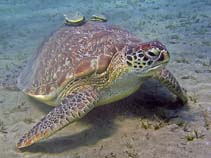Chelonia mydas (Linnaeus, 1758)
Green sea turtle| Native range | All suitable habitat | Point map | Year 2050 |

|
| This map was computer-generated and has not yet been reviewed. |
| Chelonia mydas AquaMaps Data sources: GBIF OBIS |
Classification / Names Common names | Synonyms | CoL | ITIS | WoRMS
Not assigned | Testudines | Cheloniidae
Environment: milieu / climate zone / depth range / distribution range Ecology
Pelagic; depth range 0 - 200 m (Ref. 417). Tropical; 61°N - 42°S, 97°W - 128°W (Ref. 1397)
Distribution Countries | FAO areas | Ecosystems | Occurrences | Introductions
Circumglobal.
Length at first maturity / Size / Weight / Age
Maturity: Lm ?, range 88 - 99 cm Max length : 105 cm CL male/unsexed; (Ref. 417); common length : 90.0 cm CL male/unsexed; (Ref. 417); max. published weight: 1.4 t (Ref. 418)
Short description Morphology
Smaller species under genus Chelonia. Adults carapace are strongly elevated or vaulted. In large females, carapace is less round profile in frontal view than in Chelonia mydas. In dorsal view, carapace is subcardiform and slightly emarginate over the neck and fore flippers, and deeply emarginate over the rear flippers. In subadults and young turtles, indentations are present in the last third of the carapace between each marginal scute. The carapace width 76 to 82% of its straight-line length (SCL), usually becomes narrower with age. The head is small and blunt. Carapacial scutes have 5 centrals, 4 pairs of laterals and 11 pairs of marginals. In ventral view, on the plastron, the scutes are less thick than those of the carapace. Scute counts 6 pairs plus 4 inframarginals at each side. Head with one pair of elongated prefrontal scales and 4 postorbital scales at each side (variable from 2 to 5). Tomium of lower jaw serrated. Serrations corresponds with strong ridges on the inner surface of the upper tomium. Each flipper at the outer border has a single visible claw. Adults color in dorsal view are dark. Carapace slate grey to black, with a blotched or radiating brown and olive pattern, with or without yellow radiating stripes; upper surfaces of the head and flippers plain dark. Plastron varying from whitish grey to bluish or olive-grey. Young individuals are more colorful and brighter. Some adult turtles have the carapace covered by a coat of microscopic green algae, giving a lustreless greenish color. Hatchlings carapace and flippers dorsally are very dark brown or black with a narrow white border; ventrally white same as Chelonia mydas.
The total catches in 1987 are: 864 metric tons for FAO area 77 and 305 metric tons for FAO area 87 (Ref. 1397). Exploited for their eggs, shell, and flesh that are used for food and medicinal purposes (Ref. 85371). Considered to be the best species for commercial ranching or farming but capturing green turtles was forbidden; although for some areas, it still persists. Inadvertently caught in trawls (Ref. 1397). This species is not at risk of global extinction, rather subpopulations in different areas may become extinct if not dealt with, thus regional population listings are important for better conservation assessments (Ref. 83887).
Life cycle and mating behavior Maturity | Reproduction | Spawning | Eggs | Fecundity | Larvae
Gonochorism. Two year breeding interval; can also breed in cycles of 1, 3 or 4 years or may switch from one cycle to another depending on age, food quantity and quality. Usually successive nestings are separated by two week intervals, which often lays 2 to 5 clutches per season. Nesting peaks differs in response to variations in localities (Ref. 1397). Mating system of green turtles is called scramble polygamy, which is when males competitively search for receptive females. Individual males are thus observed to mate with several females within the same season (Ref. 66637). Their secondary sexual characteristic is a longer prehensile tail with terminal nail, larger, recurved claws on the front flippers and a soft, more concave plastra (Refs. 85357, 85358). This characteristic is important for successful mounting in the face of intrasexual agonism, which is common for this species (Ref. 85356). Sexual dimorphism also exists for this species, males being a smaller size and females being larger. This helps males be efficient at foraging, defending their territories, and performing elaborate courtship displays which is favored by females. The larger size of females on the other hand, favors them since it allows them to lay more large-sized eggs (Ref. 66637).
Main reference
References | Coordinator | Collaborators
Hirth, H.F. 1993. (Ref. 97534)
IUCN Red List Status (Ref. 130435: Version 2024-1)
Endangered (EN) (A2bd); Date assessed: 30 April 2004
CITES status (Ref. 108899)
Appendix I: International trade banned
CMS (Ref. 116361)
Appendix I & II: Endangered migratory species conserved through agreements
Threat to humans
Human uses
Fisheries: commercial; aquarium: commercial
FAO - Aquaculture: production; Fisheries: landings, species profile | FishSource | Sea Around Us
Tools
More information
Trophic Ecology
Ecology
Population dynamics
Life cycle
Distribution
Human Related
Aquaculture profile
Stamps, Coins Misc.
Stamps, Coins Misc.
Outreach
References
Internet sources
BHL | BOLD Systems | CISTI | DiscoverLife | FAO(Fisheries: species profile; publication : search) | Fishipedia | GenBank (genome, nucleotide) | GloBI | Gomexsi | Google Books | Google Scholar | Google | PubMed | Tree of Life | Wikipedia (Go, Search) | Zoological Record
Estimates based on models
Preferred temperature
(Ref. 115969): 15.7 - 28.9, mean 26.7 (based on 5784 cells).
Resilience
(Ref. 69278):
Low, minimum population doubling time 4.5 - 14 years (K=0.03-0.74; tm=29).
Price category
(Ref. 80766):
Unknown.



